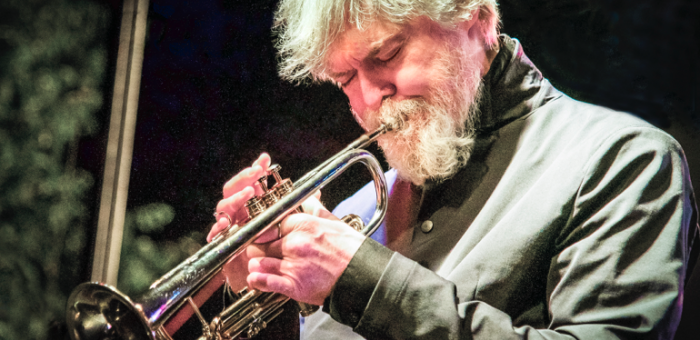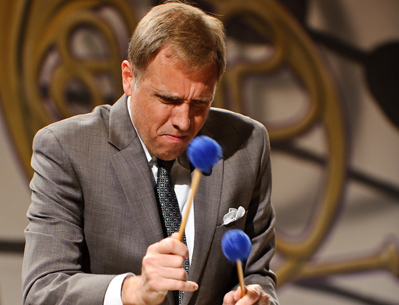Dec 9, 2025 12:28 PM
In Memoriam: Gordon Goodwin, 1954–2025
Gordon Goodwin, an award-winning saxophonist, pianist, bandleader, composer and arranger, died Dec. 8 in Los Angeles.…

Matana Roberts at the Hyde Park Jazz Festival in Chicago
(Photo: Michael Jackson)On the afternoon of Sept. 25, mulling over how to open this review as I ambled between the music stages on Midway Plaisance, a verdant stretch of Chicago’s South Side, the perfection of the summer-to-fall weather that has blessed this 10-years-young indoor/outdoor festival came to mind. Moments later, skies cracked unexpectedly and the first aggressive downpour I can recall during the history of this two-day event ensued.
It’s not over till it’s over, one might aver.
The Hyde Park Jazz Fest, which ran this year from Sept. 24–25, has traditionally been a marathon affair. The 2016 edition commenced on Saturday at 1 p.m. at the Smart Museum, and finished well past 12 a.m. with piano giant Randy Weston, who received well-wishers like a deity after his majestic solo set at Rockefeller Chapel.
During the downpour on Sept. 25, indefatigable AACM instigator Douglas Ewart convened his group Orbit—more of a “happening” than a concert—on the West Stage at Midway and Ellis. Ewart and crew set dozens of spinning tops into motion on the rain-soaked parquet dance floor, around which dancer Nicole Noland exhibited her choreography and poet Kari B obliquely intoned “We matter!”
Meanwhile, Kari B’s father, Mwata Bowden, wailed on baritone sax, Ed Wilkerson blew old-school tenor and Baba Eli Hoenai shook shekere and offered additional incantation. Also on the dance floor was a big jump rope hosted by Double Dutch team Black Girls Jump, as well as yoga and tai chi demonstrators.
The AACM remain a force in their South Side stomping grounds, and this cosmic melee was salient for its risk-taking spontaneity.
Another AACM alum, alto saxophonist and conceptualist Matana Roberts, was given two solo spots in the spectacular ninth floor penthouse of the Logan Center the previous day.
In the same spirit as Ewart, Roberts riffed in the moment and solicited audience participation. Booted in high-heeled Doc Martens, she clomped around the wood-paneled room blowing bluesy fragments and sharing anecdotes about learning from her mentors.
Among those influences were Fred Anderson, Von Freeman (whose solos she used to transcribe, trying to figure out what he was doing), Dexter Gordon and Henry Threadgill (who described the alto as ‘the Holy Ghost’ of the saxophone family).
“You made me,” she said about her hometown of Chicago, before exhorting segments of the audience to sing a tone she’d play, which she then requested them to hum back on cue. At times Roberts’ lovely alto tone recalled Miguel Zenón (particularly in the lower register), although her conception is less virtuosic than that of the Puerto Rican saxophonist, who appeared later with the University of Chicago’s own Spektral string quartet.
Zenón played a spectacular solo show in 2012 at Rockefeller Chapel and had entirely fresh music to offer this time around, though his diligent study of folkloric forms from his home country were again a focus. The commissioned pieces he offered included “Rosario,” dwelling on the Roman Catholic traditions in Puerto Rico, and “Milagroso,” which also held religious significance.
The latter indeed proved “miraculous,” a cascading composition with long, fluid, lines that Zenón delivered with impressive breath control. The strings continually buoyed and complemented the shapes from the saxophone.
For the final piece, which explored the various cadences of folk tradition, violinists Eliot Heaton and Clara Lyon, violist Doyle Armbrust and cellist Russell Rolen clapped counterpoint rhythms in 12/8 against those of the leader and then engaged in dramatic pizzicato articulations.
Zenón’s “Yo Soy La Tradition,” commissioned by inspired curator Kate Dumbleton in partnership with the Logan Center, followed an equally superb performance in the Logan Hall from Amir ElSaffar, a trenchant trumpeter who also sings in the Iraqi maqam mode and plays the santur (a hammered dulcimer). ElSaffar’s Two Rivers Ensemble mixed stretchy non-western melodies with M-base style breakbeats from drummer Nasheet Waits alongside the evocative sounds of oud and buzuq.
For several versatile local musicians, the benefits of the profusion of events across the Hyde Park Jazz Fest include the opportunity to perform multiple times in different contexts. Highlights of this year’s busy schedule came courtesy of saxophonist-composer Greg Ward, who recently returned to Chicagoland after a sojourn in New York, and tenorist Geof Bradfield.
Ward appeared in various settings: in the ranks of the Chicago Jazz Orchestra on Sept. 25, in the accompanying band for M.A.D.D. Rhythms tap ensemble at the Logan Hall, and with his own ambitious Ten Tongues orchestra, which he led through a stunning Mingus-inspired collection of material titled Touch My Beloved’s Thought.
Bradfield, meanwhile, was central to bassist Matt Ulery’s Loom ensemble and the Ba(SH) trio—with Dana Hall and Clark Sommers. Yet he also traced a highpoint in the career of tenor great Dewey Redman in a quartet that included bassist Josh Abrams, drummer Mike Reed and alto saxophonist Nick Mazzarella.
Named The Garden Of Souls after the plaintive lead-off track on Ornette Coleman’s classic 1968 album New York Is Now!, this team also explored Coleman’s “Airborne” and “Check Out Time” (recorded on the same two dates and released on the album Love Call.)
Abrams led an all-star group at International House’s grand Assembly Hall later that day featuring saxophonist Ari Brown, guitarist Jeff Parker and drummer Gerald Cleaver. The bassist explained that the music had yet to be named, and it seemed mostly composed of sketches save for the closing ballad, “In Place Of Memory.”

Goodwin was one of the most acclaimed, successful and influential jazz musicians of his generation.
Dec 9, 2025 12:28 PM
Gordon Goodwin, an award-winning saxophonist, pianist, bandleader, composer and arranger, died Dec. 8 in Los Angeles.…

Belá Fleck during an interview with Fredrika Whitfield on CNN.
Jan 13, 2026 2:09 PM
The fallout from the renaming of the John F. Kennedy Center for the Performing Arts to include President Donald…

Flea has returned to his first instrument — the trumpet — and assembled a dream band of jazz musicians to record a new album.
Dec 2, 2025 2:01 AM
After a nearly five-decade career as one of his generation’s defining rock bassists, Flea has returned to his first…

Dec 11, 2025 11:00 AM
DownBeat presents a complete list of the 4-, 4½- and 5-star albums from 2025 in one convenient package. It’s a great…

Vibraphonist Chuck Redd found himself in the midst of a political firestorm after canceling his gig Dec. 24 at the newly renamed Trump Kennedy Center.
Jan 6, 2026 2:32 AM
The Board of Trustees at Washington, D.C.’s Kennedy Center for the Performing Arts voted on Dec. 18 to rename the…